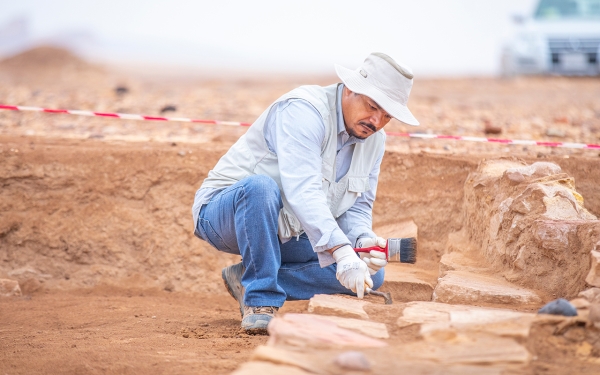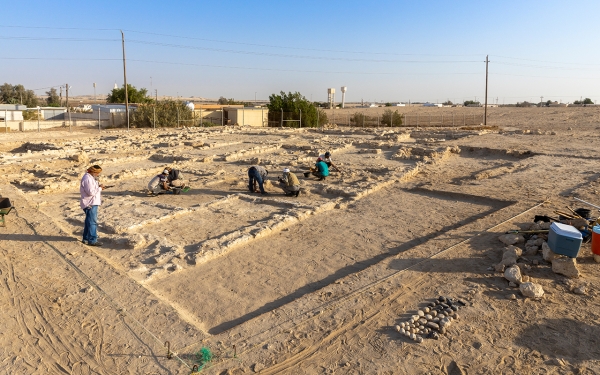


Archaeological Excavations in the Kingdom are the archaeological surveys and excavations across various Saudi sites. In that regard, the Law of Antiquities, Museums and Urban Heritage, issued by a Royal Decree in 2014, defines archaeological sites as: "Movable or immovable, buried or submerged objects, which lie within Saudi Arabia’s borders and in maritime zones under its sovereignty or jurisdiction. They are built, made, produced, adapted, or drawn by man, thus the formation of archaeological properties throughout the ages as a result of human intervention, including objects dating back to a late period, provided that they are no less than one hundred years old".
Saudi laws of antiquities
Saudi antiquities laws refer to excavation as a process that accompanies studies and research in Saudi Arabia's archaeological sites. The Antiquities Law issued in 1972 defined excavation for antiquities in Article 54 as "all excavation, searching and investigation activities aimed at finding movable or immovable antiquities weather above or underground, in the waterways, lakes or territorial waters".
This definition is almost identical to the Antiquities, Museums and Urban Heritage Law of 2014, which defines archaeological excavations as: "all excavations, examinations, searching, and diving operations which are conducted on scientific grounds to find antiquities above or underground, in waterways, lakes, or in maritime zones which fall under Saudi Arabia’s sovereignty or jurisdiction". The 2014 Law also defined the process of the archaeological survey as "the exploration of archaeological sites and documentation thereof using available scientific methods, whether above or underground, or under the water".
Archaeological sites in Saudi Arabia
Saudi Arabia enjoys a deep history since many civilizations thrived inside Saudi Arabia's territory for thousands of years. Consequently, timeless and diverse evidence was scattered across several archaeological and heritage sites, as statistics indicate that Saudi Arabia includes around 8,788 archeological sites in various regions, recorded in the National Register of Antiquities until April 2023. In 2021, the Heritage Commission approved the registration of 624 archaeological and historical sites in the National Register of Antiquities, including thirty-eight archeological sites in Makkah al-Mukarramah Province, five in Medina al-Monawarah Province, forty-eight in Hail Province, fifty-four in Al-Jawf Province, fifty-two in Asir Province, thirty-five in Tabuk Province, four in the Northern Borders Province, 342 in Riyadh, twenty-five in the Eastern Province, eighteen in Al-Qassim, and three in Jazan Province.
Through official scientific efforts, most of these sites were registered in Saudi Arabia's records and its human heritage since they are classified as features of human civilization throughout history. These sites covered all cultural and historical stages and periods of Saudi Arabia, and efforts were exerted to complete the registration of the remaining archaeological sites.
The beginning of excavations in Saudi Arabia
During the 1950s, Saudi Arabia started archaeological excavations in different sites through foreign expeditions. The Saudi government collaborated with Belgian and Canadian experts, as well as the Royal Archaeological Institute in London to uncover several crucial archeological sites.
Research, excavation, and maintenance operations in Saudi Arabia had developed and adopted a new model consisting of four axes. The first is the Saudi-German joint project in Tayma, north of Saudi Arabia. The second is the Saudi-French project that looks into Hegra. The third is the Saudi-British project which covers the Red Sea coast. The fourth relies on Saudi archaeologists in two important sites: The first is Al Khuraybah in AlUla, northwest of Saudi Arabia, and the second is related to the ruins of Al-Mabiyat, northwest of Saudi Arabia.
In an attempt to support the expansion of the search for antiquities in Saudi Arabia, the Heritage Commission launched in 2022 the Little Explorer Initiative which educates young people in all provinces about the importance of archaeological excavations, and raises the level of community participation in protecting and preserving the national heritage. The initiate is implemented across three phases. The first targets children from six to twelve years old. The second focuses on teenagers from thirteen to fifteen years old, while the third phase seeks to encourage young people to participate in excavations carried out by the Heritage Commission on an ongoing basis.
International participation in Saudi Arabia's excavations
Saudi Arabia's archeological entities cooperated with a number of Saudi, European and Asian research and exploration teams. In 2017, five of these teams carried out excavations in more than one site in Tabuk. They consisted of the German expedition and the Polish team operating in Aynuna, as well as the Japanese team which works in Al Muharraq valley, the Saudi-French team which was based in its first season in Al-Bidaa Governorate, and another joint team which operates at a village site north of Tabuk.
As excavations and surveys increased, the archaeology sector made impressive achievements that turned Saudi Arabia into a global leader in archaeological discoveries and scientific research. In 2018, over forty Saudi and international archaeological expeditions were active inside Saudi Arabia. Excavations revealed that Saudi Arabia was home to the earliest human migrations and settlements ninety thousand years ago.
To keep abreast with the archaeological excavation efforts, the Saudi Commission for Tourism and National Heritage (Currently the Ministry of Tourism) managed to regain more than fifty-three thousand artifacts in Saudi Arabia and abroad. Moreover, they were registered through a digital map as per international standards for registering and archiving data on archaeological and heritage sites and objects.
Archaeological excavation seasons in Saudi Arabia
The Heritage Commission is currently organizing archaeological surveys and excavations in Saudi Arabia. Surveys and excavations further expanded, thus taking a more comprehensive and systematic approach in their form and content, as to include more sites. Prior to the COVID-19 pandemic, Saudi Arabia witnessed the participation of more than forty joint Saudi and international expeditions in various regions of Saudi Arabia.
Archaeological surveys and excavations adopt modern scientific methods and rely on Saudi teams and international expeditions from several universities and specialized think tanks, including Whitman College, USA; the Universities of York, Liverpool, and Exeter, United Kingdom; the Centre National de la Recherche Scientifique, France; the German Archaeological Institute and Phillips University in Germany; Napoli University in Italy, University of Vienna in Austria, University of Warsaw in Poland, University of Helsinki in Finland; Kanazawa University, Waseda University, and Motoko Katakura Foundation in Japan; as well as the Chinese National Center for Cultural Heritage; and Queensland University in Australia.
As for archaeological surveys and excavations by Saudi expeditions, they are currently active in six archaeological sites. The national expeditions include teams from the Universities of King Saud, Hail, Jizan, and the Arab East Colleges for Postgraduate Studies, in collaboration with the Ministry of Tourism, public universities, and Saudi private colleges. Moreover, a number of archaeological surveys and excavation projects are implemented in sixteen sites across different regions of Saudi Arabia dating back more than a million years from prehistoric times to Islamic times (sixteenth century AD).
New archaeological discoveries in Saudi Arabia
Archeological excavations in Saudi Arabia have yielded some very significant findings. For instance, in 2020, a joint Saudi-international team unearthed footprints of humans, elephants, and predators around an ancient dried-out lake on the outskirts of Tabuk. These footprints date back more than 120,000 years ago. This finding is the first scientific evidence of the early human presence on the Arabian Peninsula. Moreover, it provides a glimpse into the living creatures that lived beside humans as they moved to and through that area.
Additional findings were uncovered through this archaeological survey, as the footsteps of seven different humans were identified, as well as traces of camel and elephant hooves, and two other species of goats and Bovidae. Moreover, around 233 fossils were found, representing elephant and oryx bone remains. These findings reflect the long and rich pre-historic era of the Arabian Peninsula and the vital role it played in human evolution.
Several cultural discoveries have also been revealed through surveys and research activities across various regions of Saudi Arabia. In 2021, an archaeological team working in AlUla, northwest of Saudi Arabia, found dog bones inside a burial site among the most ancient tombs in the country, which are contemporary with other burial sites that have been discovered and dated further north in the Levant. The earliest use of the tomb dates back to 4,300 B.C. This is the oldest evidence of domesticated dogs living side-by-side with humans across the Arabian Peninsula.
These discoveries were possible thanks to the efforts of a joint team, with Saudi, Australian and European experts, that focused its excavations on two aboveground burial sites dating back to the fourth and fifth millennia B.C. Archaeologists unearthed twenty-six dog bones, along with the skeletal remains of eleven human beings, including six adults, one teenager, and four children.
The history of human presence in Saudi Arabia
With time, survey and excavation operations resulted in several discoveries across various regions of Saudi Arabia. In 2021, new archaeological discoveries were made in the north of Saudi Arabia. These discoveries revealed strong indications of early human migrations from Africa to the Arabian Peninsula that started around four hundred thousand years ago. These migrations, dating back to 300,000, 200,000, 130,000-75,000 and 55,000 years ago, were recurrent over multiple periods of time, thus reflecting the longest record of early human presence on the Arabian Peninsula.
These discoveries helped shape a more comprehensive view of human and cultural progression across Saudi Arabia. A scientific study uncovered the existence of the Acheulean stone industries dating back to 200,000 years ago. Khal Amishan, located in al-Nufud al-Kabir Desert, on the outskirts of Tabuk, is one of the prominent archeological sites. The earliest archaeological layer at the site, dating back to 400,000 years, revealed Acheulean axes. These are the earliest archaeological findings in the Arabian Peninsula.
Archaeological surveys have covered several sites across Saudi Arabia. Coupled with advanced scientific explorations, these surveys yielded many results. In 2021, the findings of the first documented Aechulean site across Saudi Arabia, in Al-Naseem in the Nafud desert, Hail, north of Saudi Arabia, have shown ecological evidence of a deep lake that may have been made up of freshwater, along with other ancient ecological indications and related archaeological objects that date back to the Middle Pleistocene age.
Al-Naseem has substantial historical and scientific significance, being the oldest documented Aechulean site in Saudi Arabia thus far. The site also sheds light at the regional level on various sets of stone tools used by humans of the Middle Pleistocene age. This indicates that inhabitants repeatedly entered the Arabian Peninsula during the Green Arabia phase when it was full of rivers and green lands. The site contains a deep basin where several archaeological artifacts from the Early Stone Age were located. Moreover, around 354 stone axes and various stone formations were collected.
Related quizzes
Related articles
